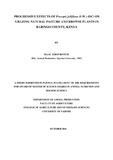| dc.description.abstract | Prosopis juliflora, a fast spreading and coppicing tree, was introduced in Kenya in 1973 to rehabilitate the degraded lands. The trees quickly replaced the natural grazing grasses, sedges, forbs and browse plants important for livestock feeding in Marigat and have been classified by International Union for Conservation of Nature as an invasive species. To understand Prosopis juliflora effect on plant species and to eventually develop mechanisms of minimizing its spread, necessitated an ecological study on the effects its progressive spread has on the biomass production, density and nutrient composition of grasses, sedges, forbs, shrubs and trees leaves and twigs species. Three sites based on terrain and vegetation cover were chosen for the study, largely described as riverine wooded grassland, plain wooded grasslands and hillslopes wooded grasslands. Areas with 0-30%, 31-64% and 65-100% Prosopis juliflora cover were selected in each site using ocular estimation and line-intercept method. Random 20m x 20m study plots replicated 4 times were demarcated and their GPS coordinates recorded. A 1m x 1m quadrat was tossed 3 times randomly within each plot to enable identification, counting, sample clipping and weighing of different grasses, sedges, forbs, dwarf shrub and tree leaves and twigs for determination of biomass, count and nutrient contents. Samples were collected 2 months into the dry season, between 18th December 2008 and 23rd January 2009 when diversity, growth and nutrient content were expected to be optimal. Chemical analyses of collected samples was done to determine crude protein, and Crude fibre content in the different plant species under the 3 canopy covers of Prosopis juliflora. The study revealed a decline of count for different plant species as canopy cover increased from 21%, 54% and least at 83%. However, annual grasses under canopy 54% increased. Biomass yield of different plant species and their categories of palatability declined as canopy cover increased from 21%, 54% and least at 83%. The density of key palatable plant species changed with canopy 21%, 54% and least at 83%. However, shading did not affect the levels of Crude Protein, Acid Detergent Fibre and Neutral Detergent Fibre. The canopy cover of Prosopis juliflora affected the total biomass production by reducing the palatable and unpalatable species and increasing the biomass production of the medium palatable species significantly (P<0.05). The results pointed out that reduction in grazing pasture and browse plants was the biggest problem followed by Prosopis juliflora shading effects on the vegetation they come in contact with, therefore reducing grazing land. There is need therefore to identify spread control measures for Prosopis juliflora, canopy cover control and grass reseeding while at the same time developing technologies for its utilization xv
as animal feed and alternative land use systems. Definitions and operational terms were also defined.
Key words: Prosopis juliflora, plant habit, biomass, count composition, protein, fibre, palatability. | en_US |



